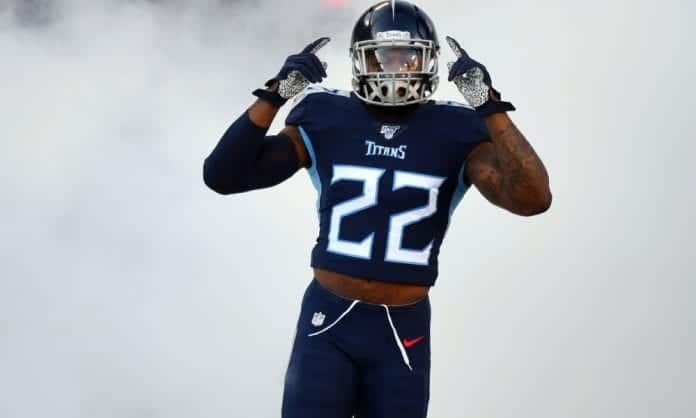Derrick Henry was a part-time player for the Tennessee Titans offense during his rookie season. However, the 2019 rushing champion still had the top-ranked performance by Offensive Share Metric (OSM) in 2016 despite producing a box score stat line most running backs would like to forget.
Henry received the top single-game grade from any running back in 2016, which he earned in the Titans’ Week 14 victory over the Denver Broncos.
Rather than being a devastating harbinger of the type of destructive displays he has consistently produced after becoming the focal point of the Titans rushing attack, Henry had to work hard a mediocre yardage total in a game the Titans won 13-10.
Though his contribution was not one that stands out in the box score, Henry still played a critical role amid circumstances he may have to regularly cope with this season if the Titans passing game struggles in 2020.
An underwhelming stat line
OSM uses the NFL’s NextGen Stats and a series of algorithms to assess a player’s influence on his offense’s production by looking at the factors only he could control.
Henry received a grade of 41.18 for his efforts in Week 14, indicating an elite level of performance.
He did so having finished the game with 42 yards on 12 carries, an average of 3.5 yards per rush.
It may be bemusing to see a player with such underwhelming statistics finish with the top single-game grade at his position.
However, Henry – having made a positive contribution to all three scoring drives – was worthy of such a score after making the most of what little room he had to work with as he consistently faced loaded boxes.
Henry fights loaded fronts
Only two teams ran the ball more frequently than the Titans did under Mike Mularkey in 2016. According to Sharp Football Stats, Tennessee called a run on 47 percent of their offensive snaps, and the Titans leaned on the ground game particularly hard against the Broncos.
Indeed, they logged 42 rushing attempts compared to just 21 passes. With DeMarco Murray playing the bulk of the snaps in the backfield, it was evident that the Titans were running the ball when Henry entered the game.
It was, therefore, no surprise that, per NextGen Stats, Henry faced at least eight defenders in the box on 91.67 percent of his carries in Week 14.
His production was not efficient, but Henry still did an impressive job of taking advantage of the openings that came his way, despite facing crowded boxes. On the other hand, he did miss an opportunity for a significant gain in the second quarter.
Modest but crucial success
Henry missed the chance for a huge play as he muffed the opportunity to break his run towards a gaping hole to his right, instead cutting to his left and running up the middle to gain six yards.
Later in the same drive, which ended in a field goal that put the Titans 13-0 to the good, Henry again gained six yards with a carry on second down but demonstrated a clear improvement in his vision.
Part of his modest success against the Broncos despite the loaded boxes he faced came as a result of Henry’s ability to get skinny through the hole. He demonstrated this on a five-yard gain that saw him carry defensive lineman Derek Wolfe with him for additional yardage.
The Titans have developed a passing game that is much more effective than the one they had under Mularkey in 2016, meaning teams have not been able to pack the box against Henry since he became the lead back in Tennessee.
However, coming off a 2019 season that saw him rack up 1,540 yards on the ground, defenses may look to adopt that approach to stop Henry from having the same impact in 2020. The pressure, therefore, is firmly on the Titans’ offensive coordinator.
Pressure on Tannehill and Smith
The Titans surged to the AFC Championship game after a superb second half of the 2019 campaign in which they were just as impressive throwing the ball as Henry was running it.
Henry was remarkably efficient for a back who carried the ball a league-high 303 times, averaging 5.1 yards per attempt.
Related | Is Derrick Henry a legitimate NFL MVP candidate?
It is unrealistic to expect Henry to be given the same number of carries in 2020. The challenge for the Titans lies in maintaining the passing game effectiveness they showcased with Ryan Tannehill under center last year.
Tannehill was fourth in the NFL in completion percentage (70.3), and average completed air yards (7.5) in 2019, according to NextGen Stats. However, should last season’s Comeback Player of the Year revert to his pre-Titans type, Henry can expect to see defenses loading up to stop him as the Broncos did in 2016.
Will defenses be able to stop Henry?
Henry, who faced at least eight men in the box on 35.3 percent of his carries last season, has the skill set to find the running lanes when met with crowded boxes and proved as such in his rookie season against the Broncos. Yet, as the was case in 2016, it can be extremely tough sledding against such loaded fronts even for backs blessed with Henry’s fearsome combination of size, speed, and power.
In a low-scoring game with Denver, Henry succeeded in having a crucial influence on the Titans despite the Broncos focusing on shutting him down.
The odds of him enjoying a decisive impact amid similar circumstances in 2020 and propping up the offense should Tannehill and the passing game falter are slim. Henry has established himself as one of the league’s premier running backs but, for him to retain that status this season, Smith and Tannehill must ensure he has the requisite space to maintain his dominance.

